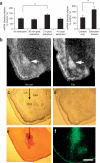Amygdala BDNF signaling is required for consolidation but not encoding of extinction
- PMID: 16783370
- PMCID: PMC2562628
- DOI: 10.1038/nn1718
Amygdala BDNF signaling is required for consolidation but not encoding of extinction
Abstract
Brain-derived neurotrophic factor (BDNF) acting through the tyrosine kinase B receptor (TrkB) is thought to be a critical mediator of learning. As there are no available selective antagonists of TrkB, we used a lentivirus encoding a dominant-negative TrkB (TrkB.t1) to antagonize BDNF signaling during extinction of conditioned fear. Whereas TrkB.t1-infected rats showed normal within-session extinction, their retention of extinction was impaired, suggesting that amygdala TrkB activation is required for the consolidation of stable extinction memories.
Figures


References
Publication types
MeSH terms
Substances
Grants and funding
LinkOut - more resources
Full Text Sources
Other Literature Sources
Research Materials

